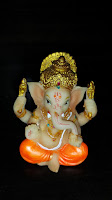Ganesha is an elephant headed God in Hinduism. He is pot-bellied, short and stout and he is loved by all. In Hinduism it is believed that any and all occasions have to be commenced by the first worship to Ganesha.
One of the names of Ganesha is Vigneshwara – which means the ‘remover of obstacles’. That is the reason for worshiping Ganesha before the commencement of any work – Ganesha removes the obstacles and this helps in the successful completion of the work.
One of the mounts of Ganesha is the mouse.
In folk stories it is very often believed that the mouse was a destructive pet as it destroyed crops. However, the mouse is placed at the foot of Ganesha with the idea that Ganesha is someone who can control even such destruction and hence Ganesha is considered as the remover of obstacles.
However, in most of the idols of Ganesha, he is shown with only one tusk.
There are countless stories in Hinduism about the single tusk of Ganesha.
The moon and its dark spots and the waning and the waxing period of the moon has been the subject of folk stories in almost all cultures.
In most of the ancient cultures, the Moon is worshiped either as a God or a Goddess. In ancient Greece, Selene is the Goddess of the Moon. Similarly, Luna is the Roman Lunar Goddess. Among ancient Egyptians, Ibis and Khonsu were male Gods of the Moon. In Hinduism, the Moon God is called as Chandra Deva.
This is the story of Ganesha and the moon.
************
Ganesha was very happy.
His devotees had given him plenty of sweets and he had taken as many as he could and stuffed himself with a lot of sweets as he was walking home.
Naturally, Ganesha was traveling on his vehicle – the mouse, and the two of them scurried along and they were back home.
As they were passing along a dense forest basking under the bright moonlight, out of nowhere, came a huge snake.
On seeing its natural enemy, Ganesha’s mouse trembled and ran from there.
Ganesha did not even have time to soothe his pet, as he fell down hard on the ground, and the sweets which he was carrying split and scattered all over the ground.
But Ganesha had a bigger problem. As Ganesha had fallen, his stomach had pierced.
Quickly, Ganesha pulled the snake with one hand and tied it as a belt around his stomach to prevent any further damage.
However Ganesha’s misadventure had not been unobserved.
The moon God – Chandra Deva saw this and unable to stop himself, the Moon God laughed.
Angrily, Ganesha pulled one of his tusk and threw it at the Moon God, breaking the moon into many pieces.
Chandra Deva was shocked but Ganesha was not yet done.
"You will always be dark!" The little Ganesha cursed the Moon God.
***********
After being cursed by Ganesha, the dark Chandra Deva pleaded with Ganesha in vain to take back his curse. But Ganesha was adamant.
 |
| Shiva |
So finally, Chandra Deva went to Shiva. Shiva is the father of Ganesha. Shiva is a three-eyed God who lives in Kailash with his wife Parvathi and two children – Ganesha and Kartikeya.
Finally with the intervention of Lord Shiva, Ganesha agreed to modify the curse on the moon and so came the fifteen days of growing moon and the fifteen days of the waning moon.
As Ganesha had plucked his tusk and threw it at the Moon to break it into
many pieces, this is believed to be as one of the reasons why Ganesha has
only one tusk.
Audio Story in Youtube























